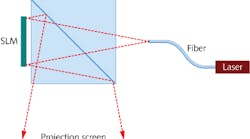Sandia's adaptive zoom riflescope offers push-button magnification
Sandia National Laboratories (Albuquerque, NM) optical engineer Brett Bagwell led the development of the Rapid Adaptive Zoom for Assault Rifles (RAZAR) prototype. At the push of a button, RAZAR can toggle between high and low magnifications, enabling soldiers to zoom in without having to remove their eyes from their targets or their hands from their rifles. "The impetus behind the idea of push-button zoom is you can acquire what you're interested in at low magnification and, without getting lost, zoom in for more clarity," Bagwell said.
Related Article
In addition to military riflescopes, RAZAR technologies are now being considered for other applications where speed, size, weight and power count. Applications include medical imaging, binoculars for the entire range of users from the military to birdwatchers, hunters’ scopes and cell phone cameras where optical zoom is needed to avoid the pixelated images associated with digital zoom.
Bagwell began work on RAZAR in 2006 responding to Department of Defense interest in a compact zoom riflescope that could rapidly toggle between magnifications. Early work had been funded by Sandia’s Laboratory Directed Research and Development program. Bagwell found no commercial products or components that would enable the riflescope to meet military requirements, so he had to design and build the first RAZAR from scratch and develop a manufacturing process.
The RAZAR prototype uses a patented active optical zoom system, called "adaptive zoom," invented by David Wick, who was working as a Sandia optical engineer at the time. Traditional optical zoom changes magnification by adjusting the positions of the lenses along the optical axis. For example, a 35-mm camera mechanically moves the lenses as you zoom in on or out from a subject. Adaptive zoom changes the focal lengths of two or more lenses by varying the curvature of the lenses’ surfaces to provide optical zoom without changing their overall positions relative to one another, allowing the user to view either a wide-angle image or zoom in on an area of interest with a compact, low-power system, Wick said.
SOURCE: Sandia National Laboratories; https://share.sandia.gov/news/resources/news_releases/razar/#.VE-p2Ve03hd
About the Author

Gail Overton
Senior Editor (2004-2020)
Gail has more than 30 years of engineering, marketing, product management, and editorial experience in the photonics and optical communications industry. Before joining the staff at Laser Focus World in 2004, she held many product management and product marketing roles in the fiber-optics industry, most notably at Hughes (El Segundo, CA), GTE Labs (Waltham, MA), Corning (Corning, NY), Photon Kinetics (Beaverton, OR), and Newport Corporation (Irvine, CA). During her marketing career, Gail published articles in WDM Solutions and Sensors magazine and traveled internationally to conduct product and sales training. Gail received her BS degree in physics, with an emphasis in optics, from San Diego State University in San Diego, CA in May 1986.

